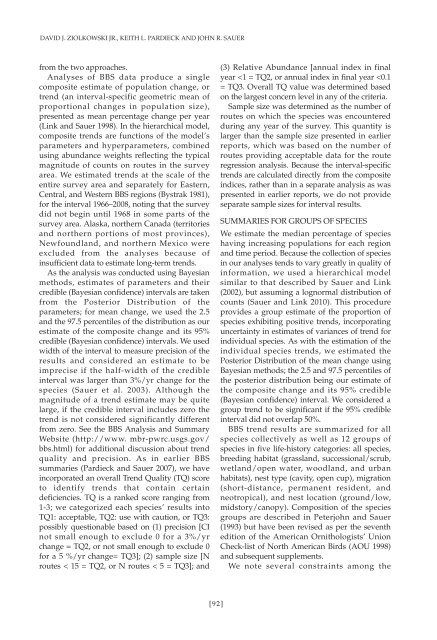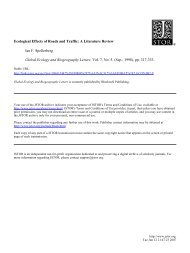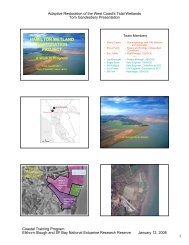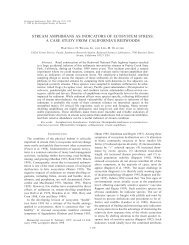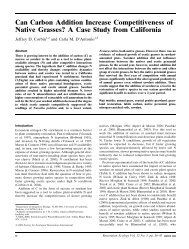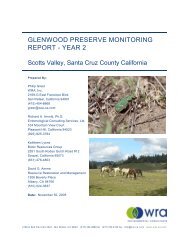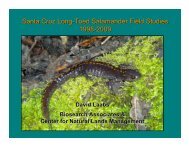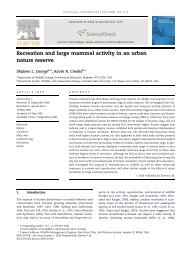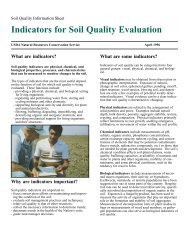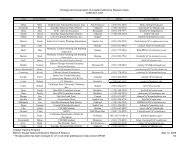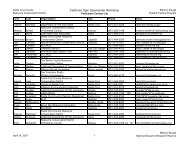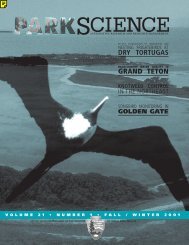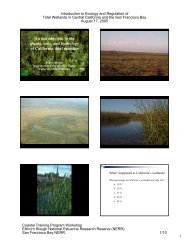DAVID J. ZIOLKOWSKI JR., KEITH L. PARDIECK AND JOHN R. SAUERfrom the two approaches.Analyses of BBS data produce a singlecomposite estimate of population change, ortrend (an interval-specific geometric mean ofproportional changes in population size),presented as mean percentage change per year(Link and Sauer 1998). In the hierarchical model,composite trends are functions of the model’sparameters and hyperparameters, combinedusing abundance weights reflecting the typicalmagnitude of counts on routes in the surveyarea. We estimated trends at the scale of theentire survey area and separately for Eastern,Central, and Western BBS regions (Bystrak 1981),for the interval 1966–2008, noting that the surveydid not begin until 1968 in some parts of thesurvey area. Alaska, northern Canada (territoriesand northern portions of most provinces),Newfoundland, and northern Mexico wereexcluded from the analyses because ofinsufficient data to estimate long-term trends.As the analysis was conducted using Bayesianmethods, estimates of parameters and theircredible (Bayesian confidence) intervals are takenfrom the Posterior Distribution of theparameters; for mean change, we used the 2.5and the 97.5 percentiles of the distribution as ourestimate of the composite change and its 95%credible (Bayesian confidence) intervals. We usedwidth of the interval to measure precision of theresults and considered an estimate to beimprecise if the half-width of the credibleinterval was larger than 3%/yr change for thespecies (Sauer et al. 2003). Although themagnitude of a trend estimate may be quitelarge, if the credible interval includes zero thetrend is not considered significantly differentfrom zero. See the BBS Analysis and SummaryWebsite (http://www. mbr-pwrc.usgs.gov/bbs.html) for additional discussion about trendquality and precision. As in earlier BBSsummaries (Pardieck and Sauer 2007), we haveincorporated an overall Trend Quality (TQ) scoreto identify trends that contain certaindeficiencies. TQ is a ranked score ranging from1-3; we categorized each species’ results intoTQ1: acceptable, TQ2: use with caution, or TQ3:possibly questionable based on (1) precision [CInot small enough to exclude 0 for a 3%/yrchange = TQ2, or not small enough to exclude 0for a 5 %/yr change= TQ3]; (2) sample size [Nroutes < 15 = TQ2, or N routes < 5 = TQ3]; and(3) Relative Abundance [annual index in finalyear
NORTH AMERICAN BREEDING <strong>BIRD</strong> SURVEY 2003-2008comparisons presented. Data from the intervalsare not independent, as the subintervals arecontained within the longer interval.Consequently, we did not formally test fordifferences among intervals, and merely notedifferences among point estimates. All tests ofthe species group analyses address the nullhypothesis that the percentage of increasingspecies does not differ from 50% within aninterval. Sample sizes and precision of estimatesdiffer among regions and time periods. Readersare cautioned that the underlying species groupsin each guild can differ among regions. See theBBS Analysis and Summary Website (www.mbrpwrc.usgs.gov/bbs)for additional discussionabout species-group results for time periods andregions.RESULTSAmong the the 426 species that we providecontinent level trend estimates for, 216 (51%)exhibited significant long-term populationchange (Table 1, Appendix 1). Of these, 85 (39%)experienced population growth and 131 (61%)showed an overall decline. The majority of thesesignificant long-term trend estimates had hightrend quality; 144 (67%) species had TQ=1, 57(26%) species had TQ = 2, and 15 (7%) specieshad TQ = 3. Continental trend estimates from themore recent 2-yr interval were similar, with 31%of all species exhibiting significant populationgrowth and 69% experiencing significantpopulation loss. This pattern was reversedduring 2003-2008, when 66% of species showedsignificant positive trends and only 34%exhibited significant declines.The results of the group analyses represent thetrend and precision estimates of all constituentspecies in aggregate, thereby providing a morerefined assessment of the proportion of speciesexhibiting increasing trends. Of the 12 lifehistorygroups in each of the three BBS regionsduring 1966-2008, only 6 saw significantly morethan half of their constituent species undergopopulation increase while 17 saw significantlymore species decline. Results during 2007-2008mirrored this long-term pattern (0 groups with>50% of species increasing vs. 7 with overalllosses) but contrasted the 2003-2008 resultswhere 13 groups saw significantly more speciesincrease and none experienced a significantlygreater proportion of declines.At the survey-wide level, 46% of all speciesexhibited positive trend estimates during 1966-2008, with the greatest proportion of increasesoccurring in the Central region (58%; Fig. 1A).All regions, but especially Western andEastern, demonstrated appreciable gains during2003-2008, with 64% of all species showingpositive trends survey-wide. The proportion ofspecies increasing survey-wide in the morerecent 2-yr interval, however, fell to 39% due todeclining populations in all regions.The grassland bird guild contained the lowestnumber of species exhibiting increasing longtermtrends of any group over the entire surveyarea (21%, Fig. 1B). The Eastern region reached asignificant low point during 1966-2008 with just5% of grassland species experiencing populationgrowth. Grassland bird trends improved in allregions during 2003-2008 with the proportion ofpositive trend estimates ranging from 25% in theEastern region to 57% in the Central region; thisapparent tendency for increase, however, wasnot significant. Percentages dropped in allregions in the 2007-2008 interval but thesedeclines also were not significant.Wetland species exhibited the greatest significantproportions of positive trend estimates inTABLE 1. Summary of Trend Quality (TQ) values for 1966-2008. Total number of species trends (N) in eachtrend category as well as their significance (P < 0.05) and direction are presented. The TQ values are defined asfollows: 1 = acceptable, 2 = use with caution, 3 = possibly questionable.Trend Number of Number of Significant Number of SignificantQuality N Significant Trends Trends: Increasing Trends: Decreasingf.All 426 216 85 1311 250 144 46 982 124 57 33 243 52 15 6 9[93]
- Page 1 and 2:
BIRD POPULATIONSA journal of global
- Page 3 and 4:
BIRD POPULATIONSA journal of global
- Page 6 and 7:
ROBERT L. WILKERSON AND RODNEY B. S
- Page 8 and 9:
ROBERT L. WILKERSON AND RODNEY B. S
- Page 10 and 11:
ROBERT L. WILKERSON AND RODNEY B. S
- Page 12 and 13:
ROBERT L. WILKERSON AND RODNEY B. S
- Page 14 and 15:
ROBERT L. WILKERSON AND RODNEY B. S
- Page 16 and 17:
ROBERT L. WILKERSON AND RODNEY B. S
- Page 18 and 19:
ROBERT L. WILKERSON AND RODNEY B. S
- Page 20 and 21:
ROBERT L. WILKERSON AND RODNEY B. S
- Page 22 and 23:
ROBERT L. WILKERSON AND RODNEY B. S
- Page 24 and 25:
ROBERT L. WILKERSON AND RODNEY B. S
- Page 26 and 27:
ROBERT L. WILKERSON AND RODNEY B. S
- Page 28 and 29:
ROBERT L. WILKERSON AND RODNEY B. S
- Page 30 and 31:
ROBERT L. WILKERSON AND RODNEY B. S
- Page 32 and 33:
ROBERT L. WILKERSON AND RODNEY B. S
- Page 34 and 35:
ROBERT L. WILKERSON AND RODNEY B. S
- Page 36 and 37:
ROBERT L. WILKERSON AND RODNEY B. S
- Page 38 and 39:
ROBERT L. WILKERSON AND RODNEY B. S
- Page 40 and 41:
NIRANJAN DAS AND SUJATA DEORIincluy
- Page 42 and 43:
NIRANJAN DAS AND SUJATA DEORIprovid
- Page 44 and 45: NIRANJAN DAS AND SUJATA DEORIpopula
- Page 46 and 47: NIRANJAN DAS AND SUJATA DEORITABLE
- Page 48 and 49: NIRANJAN DAS AND SUJATA DEORITABLE
- Page 50 and 51: NIRANJAN DAS AND SUJATA DEORITABLE
- Page 52 and 53: NIRANJAN DAS AND SUJATA DEORITABLE
- Page 54 and 55: NIRANJAN DAS AND SUJATA DEORITABLE
- Page 56 and 57: NIRANJAN DAS AND SUJATA DEORITABLE
- Page 58 and 59: Bird Populations 10:56-64© The Ins
- Page 60 and 61: WETLAND BIRDS OF GHANAAvicennia afr
- Page 62 and 63: WETLAND BIRDS OF GHANATABLE 1. Data
- Page 64 and 65: WETLAND BIRDS OF GHANATABLE 2: Esti
- Page 66 and 67: WETLAND BIRDS OF GHANAATTUQUAYEFIO,
- Page 68 and 69: JANNIK HANSEN, LARS HOLST HANSEN, N
- Page 70 and 71: JANNIK HANSEN, LARS HOLST HANSEN, N
- Page 72 and 73: JANNIK HANSEN, LARS HOLST HANSEN, N
- Page 74 and 75: JANNIK HANSEN, LARS HOLST HANSEN, N
- Page 76 and 77: JANNIK HANSEN, LARS HOLST HANSEN, N
- Page 78 and 79: JANNIK HANSEN, LARS HOLST HANSEN, N
- Page 80 and 81: JANNIK HANSEN, LARS HOLST HANSEN, N
- Page 82 and 83: JANNIK HANSEN, LARS HOLST HANSEN, N
- Page 84 and 85: JANNIK HANSEN, LARS HOLST HANSEN, N
- Page 86 and 87: JANNIK HANSEN, LARS HOLST HANSEN, N
- Page 88 and 89: JANNIK HANSEN, LARS HOLST HANSEN, N
- Page 90 and 91: BIRD POPULATIONSA journal of global
- Page 92 and 93: Bird Populations 10:90-109© The In
- Page 96 and 97: DAVID J. ZIOLKOWSKI JR., KEITH L. P
- Page 98 and 99: DAVID J. ZIOLKOWSKI JR., KEITH L. P
- Page 100 and 101: DAVID J. ZIOLKOWSKI JR., KEITH L. P
- Page 102 and 103: DAVID J. ZIOLKOWSKI JR., KEITH L. P
- Page 104 and 105: DAVID J. ZIOLKOWSKI JR., KEITH L. P
- Page 106 and 107: DAVID J. ZIOLKOWSKI JR., KEITH L. P
- Page 108 and 109: DAVID J. ZIOLKOWSKI JR., KEITH L. P
- Page 110 and 111: DAVID J. ZIOLKOWSKI JR., KEITH L. P
- Page 112 and 113: Bird Populations 10:110-113© The I
- Page 114 and 115: THE 2007 AND 2008 NORTH AMERICAN BR
- Page 116 and 117: Bird Populations 10:114-124© The I
- Page 118 and 119: BREEDING BIRD CENSUS: 2007on the pl
- Page 120 and 121: BREEDING BIRD CENSUS: 2007May, with
- Page 122 and 123: BREEDING BIRD CENSUS: 2007Remarks:
- Page 124 and 125: BREEDING BIRD CENSUS: 200717. PITCH
- Page 126 and 127: BREEDING BIRD CENSUS: 2007+; Wester
- Page 128 and 129: BREEDING BIRD CENSUS: 2008gray Gnat
- Page 130 and 131: BREEDING BIRD CENSUS: 2008Warbler,
- Page 132 and 133: BREEDING BIRD CENSUS: 2008Source: W
- Page 134 and 135: BREEDING BIRD CENSUS: 2008Spotted T
- Page 136 and 137: BREEDING BIRD CENSUS: 2008precipita
- Page 138 and 139: Bird Populations 10© The Institute
- Page 140 and 141: IS AVIAN BREEDING SUCCESS WEATHERIN
- Page 142 and 143: IS AVIAN BREEDING SUCCESS WEATHERIN
- Page 144 and 145:
DAVE LEECH AND CARL BARIMOREFlycatc
- Page 146 and 147:
Bird Populations 10:143-145Reprinte
- Page 148 and 149:
WOODPIGEON JOINS THE GARDEN PREMIER
- Page 150 and 151:
CHANGING THE GUARD AT UK BIRDTABLES
- Page 152 and 153:
Bird Populations is an entirely ele
- Page 154:
BIRD POPULATIONSA journal of global


